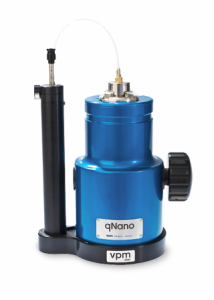It was the word femtomolar that did it for me. While I have somehow managed to conceptualize the nanoscale, the other scales (pico, femto, atto, zetto, and yocto) continue to elude me. If my experience with the ‘nanoscale ‘ is any guide, the only solution will be to find as much information as I can on these other ones and immerse myself in them. With that said, here’s more from the July 19, 2012 Izon press release,
Researchers at the Lee Bionanosciences Laboratory at UCD [University College Dublin] School of Chemistry and Chemical Biology in Dublin have demonstrated the detection and measurement of biological analytes down to femtomolar concentration levels using an off the shelf qNano instrument. This ultra low level biodetection capability has implications for biomedical research and clinical development as trace amounts of a biological substance in a sample can now be detected amd quantfied using standard commercially available equipment.
…
Platt [Dr Mark Platt] and colleagues’ [Professor Gil Lee and Dr Geoff Willmott] method for femtomolar-level detection uses magnetic particle systems and can be applied to any biological particle or protein for which specific aptamers or antibodies exist. Resistive pulse sensing, the underlying technology of the qNano [Izon product], was used to monitor individual and aggregated rod-shaped nanoparticles as they move through tunable pores in elastomeric membranes.
Dr Platt says, “The strength of using the qNano is the ability to interrogate individual particles through a nanopore. This allowed us to establish a very sensitive measurement of concentration because we could detect the interactions occurring down to individual particle level.
…
”The unique and technically innovative approach of the authors was to detect a molecule’s presence by a process that results in end on end or side by side aggregation of rod shaped nickel-gold particles. The rods were designed so that the aptamers could be attached to one end only.
“By comparing particles of similar dimensions we demonstrated that the resistive pulse signal is fundamentally different for rod and sphere-shaped particles, and for rod shaped particles of different lengths. We could exploit these differences in a new agglutina¬tion assay to achieve these low detection levels,” says Dr Platt.
In the agglutination assay particles with a particular aspect ratio can be distinguished by two measurements: the measured drop in current as particles traverse the pore (∆ip), which reveals the particle’s size; and the full width at half maximum (FWHM) duration of the resistive pulse, which relates to the particle’s speed and length. Limits of detection down to femtomolar levels were thus able to be demonstrated.
I’m a little unclear as to what qNano actually is. I did find this description on the qNano product page,
qNano uses unique nanopore-based detection to enable the physical properties of a wide range of particle types to be measured with unsurpassed accuracy.
Detailed Multi-Parameter Analysis.
Particle-by-particle measurement through qNano enables detailed determination of:
Nanopore-based detection allows thousands of particles to be measured individually, providing far greater detail and accuracy than light-based techniques.
Applications & Particle Types
A wide range of biological and synthetic particle types, spanning 50 nm – 10 μm, can be measured, across a broad range of research fields.
qNano Package
qNano is sold as a full system ready for use including the base instrument, variable pressure module, fluid cell and a starter kit of nanopores, buffer solution and standard particle sets.
Here’s what the product looks like,
As for what this all might mean to those of us who exist at the macroscale (from the Izon press release),
Izon Science will continue to work with Dr Platt at Loughborough, and with University College Dublin and various customers to develop a series of diagnostic kits that can be used with the qNano to identify and measure biomolecules, viruses, and microvesicles.“This is a real milestone for Izon’s technology as being able to measure biomolecules down to these extremely low levels opens up new bio-analysis options for researchers. 10 femtomolar was achieved, which is the equivalent dilution to 1 gram in 3.3 billion litres, or 1 gram in 1300 Olympic sized swimming pools,” says Hans van der Voorn, Executive Chairman of Izon Science.
For those interested in finding out about nanopores, these were mentioned in my July 18, 2012 posting while aptamers were discussed in my interview (Oct. 25, 2011 posting) with Dr. Maria DeRosa who researches them in her Carleton University laboratory (Ottawa, Canada).
